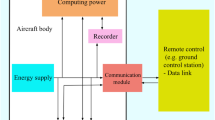Abstract
A drone swarm is a preferable way in deploying drones for large-scale missions. In establishing drone swarms, secure communication between a fog drone and several edge drones is essential to mutually authenticate each other. Although many research works proposed the designs of mutual authentications, none of them meets the adequate security for the drone swarm environments, requiring either involvement of the ground station during the authentication process or expensive PKI-based crypto operations. Only a few works proposed more lightweight authentication, however, they are still vulnerable to key compromises in addition to the limited flexibility and scalability. In this work, we propose an efficient and scalable authentication protocol for fog-edge drone swarm environments, enabling mutual authentication between fog and edges without involving the ground station. We also show the design can leverage various hardware-assisted security functions. Protocol evaluations show security requirements satisfaction while achieving 14–20 times less computation overhead as compared to PKI-based models.
Access this chapter
Tax calculation will be finalised at checkout
Purchases are for personal use only
Similar content being viewed by others
References
Abdel-Malek, M.A., et al.: A proxy Signature-Based drone authentication in 5G D2D networks. In: 2021 IEEE 93rd Vehicular Technology Conference (VTC2021-Spring), pp. 1–7 (2021). www.ieeexplore.ieee.org
Abdel-Malek, M.A., et al.: A proxy Signature-Based swarm drone authentication with leader selection in 5G networks. IEEE Access 10, 57485–57498 (2022)
Aydin, Y., et al.: Authentication and handover challenges and methods for drone swarms. IEEE J. Radio Frequency Identification 6, 220–228 (2022)
Barbareschi, M., et al.: A PUF-based hardware mutual authentication protocol. J. Parallel Distrib. Comput. 119, 107–120 (2018)
Barbareschi, M., et al.: PUF-enabled authentication-as-a-service in fog-IoT systems. In: 2019 IEEE 28th International Conference on Enabling Technologies: Infrastructure for Collaborative Enterprises (WETICE), pp. 58–63 (2019)
Ben Amor, A., et al.: A privacy-preserving authentication scheme in an edge-fog environment. In: 2017 IEEE/ACS 14th International Conference on Computer Systems and Applications (AICCSA), pp. 1225–1231 (Oct 2017)
Cho, G., et al.: SENTINEL: a secure and efficient authentication framework for unmanned aerial vehicles. NATO Adv. Sci. Inst. Ser. E Appl. Sci. 10(9), 3149 (2020)
Chung, T.H., et al.: Live-fly, large-scale field experimentation for large numbers of fixed-wing UAVs. In: 2016 IEEE International Conference on Robotics and Automation (ICRA), pp. 1255–1262 (2016)
Gope, P., Sikdar, B.: An efficient privacy-preserving authenticated key agreement scheme for edge-assisted internet of drones. IEEE Trans. Vehicul. Technol. 69(11), 13621–13630 (2020). https://doi.org/10.1109/TVT.2020.3018778
Ibrahim, M.H.: Octopus: an edge-fog mutual authentication scheme. IJ Network Secur. 18(6), 1089–1101 (2016)
Jan, S.U., Khan, H.U.: Identity and aggregate signature-based authentication protocol for IoD deployment military drone. IEEE Access 9, 130247–130263 (2021)
Khanh, T.D., et al.: TRA: effective authentication mechanism for swarms of unmanned aerial vehicles. In: 2020 IEEE Symposium Series on Computational Intelligence (SSCI), pp. 1852–1858 (2020)
McGrath, T., et al.: A PUF taxonomy. Appl. Phys. Rev. 6(1),(2019)
Pal, V., A et al.: PUF based secure framework for hardware and software security of drones. In: 2020 Asian Hardware Oriented Security and Trust Symposium (AsianHOST), pp. 01–06 (2020)
Pardeshi, M.S., Yuan, S.M.: SMAP Fog/Edge: a secure mutual authentication protocol for Fog/Edge. IEEE Access 7, 101327–101335 (2019)
Semal, B., et al.: A certificateless group authenticated key agreement protocol for secure communication in untrusted UAV networks. In: 2018 IEEE/AIAA 37th Digital Avionics Systems Conference, pp. 1–8 (2018)
Society of Automotive Engineers International: SAE J3101 - Hardware Protected Security for Ground Vehicles. Technical Report J3101, SAE (2020)
Tanveer, M., et al.: LAKE-IoD: lightweight authenticated key exchange protocol for the internet of drone environment. IEEE Access 8, 155645–155659 (2020)
Tanveer, M., et al.: RAMP-IoD: a robust authenticated key management protocol for the internet of drones. IEEE Internet Things J. 1–1 (2021)
Author information
Authors and Affiliations
Corresponding author
Editor information
Editors and Affiliations
Response Generation in PP.3
Response Generation in PP.3
We briefly show how the \(F_{i,j}\) in PP.3 can work in such varied environments. Note that the transactions between hardware-protected security environments (HPSE) [17] and outside are protected as the assumption in the preparation phase (PP). H(X) denotes a cryptographic hash function with an input X.
1.1 Response Generation in Generic Edge Drone
As depicted in Fig. 8(a), the edge drone generates a random unique value \(seed_{i,j}\) using the random number generator and securely stores it in the secure storage.
Once \(C_i\) is received, \(ed_{i,j}\) performs following.
Response \(R_{i,j}\) is stored within the HPSE and not disclosed to any other entity but only to the valid ground station.
1.2 Response Generation in Edge Drone with PUF
We focus on PUFs in two categories; weak and strong PUFs. That strength depends on the number of challenge-response pairs (CRPs) that can be generated from a single device. For more detail, please refer to [13].
Since weak PUF generates the constant output all the time, as depicted in Fig. 8(b), \(F_{i,j}\) generates \(R_{i,j}\) as following:
In contrast, as the strong PUF could generate CRPs without limitation, as depicted in Fig. 8(c), \(F_{i,j}\) generates \(R_{i,j}\) as following:
Rights and permissions
Copyright information
© 2022 Springer Nature Switzerland AG
About this paper
Cite this paper
Han, K., Nuaimi, E.A., Blooshi, S.A., Psiakis, R., Yeun, C.Y. (2022). A New Scalable Mutual Authentication in Fog-Edge Drone Swarm Environment. In: Su, C., Gritzalis, D., Piuri, V. (eds) Information Security Practice and Experience. ISPEC 2022. Lecture Notes in Computer Science, vol 13620. Springer, Cham. https://doi.org/10.1007/978-3-031-21280-2_10
Download citation
DOI: https://doi.org/10.1007/978-3-031-21280-2_10
Published:
Publisher Name: Springer, Cham
Print ISBN: 978-3-031-21279-6
Online ISBN: 978-3-031-21280-2
eBook Packages: Computer ScienceComputer Science (R0)




